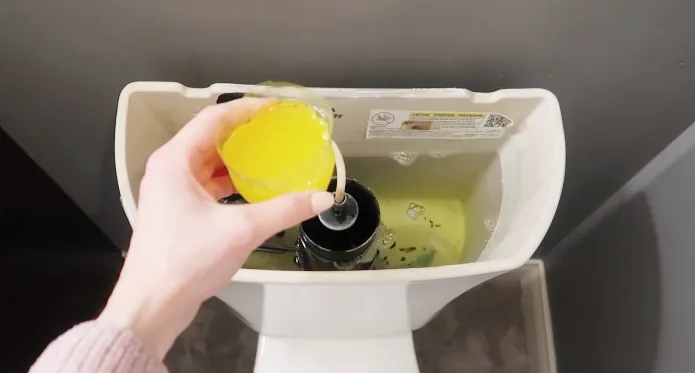Last Updated on October 17, 2023
Vacations are all about taking a break, but it shouldn’t mean dirtier toilets. With careful maintenance, all those stains, dirt, viruses, and bacteria buildup won’t come between you and restful relaxation after arriving home.
Refresh your bathroom hygiene routine by regularly using one of these powerful cleansers: acidic & enzymatic toilet bowl cleaner, chlorine bleach, white vinegar and baking soda for extra sparkle, hydrogen peroxide to deep clean those hard-to-reach places.
For a more natural option, try lemon juice. Flush the system & cover the bowl, and you’ll have spotless surfaces that stay clean.
Read on for more tips that’ll have you enjoying fresh bathrooms all holiday season.
How to Keep Toilet Bowl Clean While on Vacation: A Complete Guide
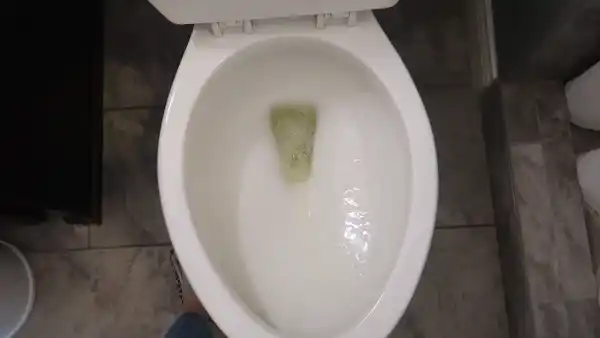
Keeping the toilet bowl clean while on vacation is essential for a healthy and stress-free holiday. Toilet bowl cleaners are essential tools for achieving this goal as they can quickly and effectively help remove dirt, debris, and bacteria from the surface of your toilet bowl.
Several toilet bowl cleaners available in the market can help make this task easier and more efficient. Here is an overview of some of them and how to use them to clean your toilet bowl while on vacation.
Step 1: Using Toilet Bowl Cleaner:
Whether it’s acidic or enzymatic, choosing wisely can make all the difference in keeping your bathroom hygienic. Which type will you pick to keep yours fresh?

1. Acidic Toilet Bowl Cleaner:
Acidic toilet bowl cleaners are a great way to sanitize your toilet bowl while on vacation. These cleaners contain acid compounds such as hydrochloric acid and phosphoric acid, which help to break down dirt and grime build-up in your bowl.
They come in various forms, such as liquid, powder, gels, and tablets, making them easy to use wherever you travel. The benefits of using acidic toilet bowl cleaner include quickly removing stubborn stains by scrubbing gently. It also kills germs and bacteria effectively while leaving behind a pleasant scent.
2. Enzymatic Toilet Bowl Cleaner:
Enzymatic toilet bowl cleaners typically contain enzymes like protease and amylase, which help break down dirt without damaging surfaces like porcelain or marble. They often contain other ingredients, such as non-combustible absorbent material and surfactants, for better performance on hard water stains/mineral deposits.
These types of cleaners come in ready-to-use sprays or liquids that are applied directly onto surfaces such as crevices within tile grout lines where regular brushes may not reach easily.
The benefit of using an enzymatic cleaner is its gentler nature compared to acid. It won’t corrode surfaces over time due to its lower pH level, nor emit toxic fumes like other chemical-based products do when used in large quantities.

Process of Using Liquid and Gel Toilet Bowl Cleaner:
- Begin by flushing the toilet and then apply 4 ounces of the cleaner around the bowl, including under the rim. Make sure not to close the lid so that the solution can do its job properly.
- Take a brush and scrub around the entire bowl as well as under the rim. This will help release any built-up dirt and debris from inside and outside of your toilet bowl.
- Let the cleaner sit on the surface for 15 minutes in order to disinfect it before taking a cloth rag and wiping down any excess product or dirt left behind.
- For sanitizing purposes, leave it on for 30 seconds before rinsing it off with fresh water.
- Rinse your brush off in fresh water so you don’t contaminate your cleaning supplies, and repeat this process if necessary.
Process of Using Tablet and Powdered Toilet Bowl Cleaner:
- Just take out one tablet from its box and drop it into the tank of your toilet before leaving for your trip.
- Wait at least 30 minutes until the water turns blue before flushing so that enough time is allowed for the dissolution of the tablet’s components.
- Keep in mind not to remove its water-soluble protective film as it ensures hygienic protection against germs and bacteria during use.
3. Chlorine Bleach:
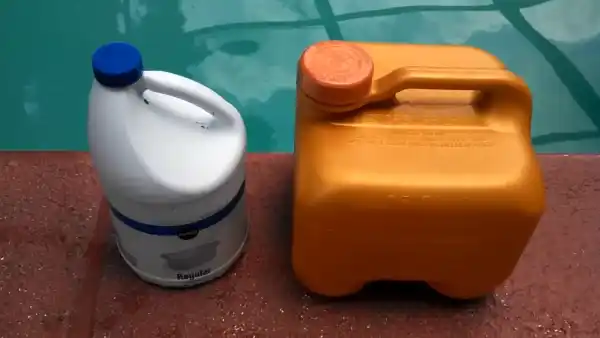
Chlorine bleach is another effective way of keeping your toilets clean while on vacation since it has strong germ-killing properties, which makes it great at removing dirt, grime, and bad odors quickly without having to scrub too hard.
It also works well against mold growth which may have accumulated over time due to high humidity levels from bathrooms being constantly used.
Process of Using Chlorine or Bleach:
- Begin by pouring a generous half cup of chlorine/bleach into the bowl.
- Leave it in for around 1/2 hour, and then scrub the bowl with a brush.
- To remove any remaining residue, give the bowl one last flush.
4. White Vinegar & Baking Soda:
White vinegar & baking soda offers an eco-friendly option for those looking at ways of keeping their toilets clean while away from home since both these ingredients are natural cleaning agents that don’t contain any harsh chemicals like many commercial alternatives do.
The magical pairing of white vinegar and baking soda makes for a remarkable duo that can tackle even the toughest dirt, bacteria & germs. Their combined strength creates an unstoppable force.
Furthermore, this method doesn’t produce any nasty smells like some other cleaning techniques do, making it ideal for getting rid of unwanted odors coming from your bathroom.
Process of Using White Vinegar & Baking Soda:
- Start off by sprinkling baking soda liberally onto the stains in the toilet bowl and then use your scrub brush to create a paste over the entire inside of the bowl.
- Let this miracle solution do its magic for 10 minutes and watch the stain vanish. Meanwhile, any discoloration caused by hard water deposits or soap scum over time will be brightened up.
- After 10 minutes, pour 2 cups of distilled white vinegar into the bowl to unleash a gas that will help tackle tough deposits from calcium and magnesium.
- Secure the lid of your toilet, step back and let it soak for 30 minutes.
- Come back refreshed with a brush in hand to give it an invigorating scrub before dowsing any remaining grime away with some water.
5. Hydrogen Peroxide:
Hydrogen peroxide is another excellent cleaner for keeping toilets sparkling while on vacation. It has powerful oxidizing properties that can help remove stubborn stains from porcelain surfaces without damaging them like harsher chemical cleaners might do.
Additionally, hydrogen peroxide breaks down organic matter quickly which makes it an ideal choice for eliminating tough stains in hard-to-reach places like behind the rim or further down in plumbing pipes or drains leading away from the toilet bowl itself.
It’s also effective against mold growth which can be problematic if left unchecked after extended periods of disuse during vacations or holidays away from home.
Process of Using Hydrogen Peroxide:
- Pour half a cup of hydrogen peroxide into the toilet bowl and let it sit for 30 minutes.
- Then use an old brush or scrubber with some baking soda to remove any stubborn stains or dirt.
- Flush the toilet afterward to get rid of any remaining germs and grime.
6. Lemon Juice:

Lemon juice is yet another great natural ingredient you can use when trying to keep your toilet bowl clean while on vacation. With citric acid, hard water minerals are broken down, making them easier to wipe away during the scrubbing process without the need for special soap softener products.
Its natural scent also helps freshen bathrooms, helping maintain pleasant aromas throughout the entire household.
Process of Using Lemon Juice:
- Mix one cup of lemon juice with half a cup of water in a spray bottle.
- Spray this mixture over the inner surface of your toilet bowls, including beneath the seat lip.
- Leave it like that for 20 minutes before scrubbing off any remaining stains or dirt with a toilet brush or scrubber.
- Finish by flushing away any remaining residue for squeaky-clean results.
Step 2: Put Marine Antifreeze in the Toilet Bowl:
After using the cleaner, fill up a bucket with hot water and add a few drops of marine antifreeze or another similar product designed to prevent freezing in pipes during winter months.
This added layer of protection will help keep your toilet bowl from freezing up while you are away on vacation in colder climates or areas susceptible to freezing temperatures during winter months.
Step 3: Cover the Toilet Bowl
Keep your toilet tank funky-free by using a rag, towel, or saran wrap to cover the lid. This simple step will help keep dust particles out and prevent moisture evaporation caused by direct sunlight exposure, ensuring you have a cool, clean look.
Find some way to seal off other potential sources of moisture such as windows or vents near your bathroom so that no additional moisture enters into that area while vacating elsewhere.

Practical Strategies for Maintaining Clean Toilet Bowls before Vacation
- Establish a regular schedule for cleaning the toilet bowl (e..g., daily, weekly)
- Removing debris and stains by scrubbing them with a specialized brush
- Cleaning all toilet surfaces, including seat, lid, base, handles/knobs, etc.)
- Disinfecting all surfaces (tiles & basin) using an appropriate product
- Maintaining a clean bathroom environment overall by wiping down other surfaces such as sink countertops, door knobs/handles, floor mats/rugs, etc.)
- Empty toilet tank
- Throwing away any disposable materials used while cleaning (e.,g., paper towels)
- Leaving the lid open between uses to encourage airflow and drying out of the bowl
- Turn off the water supply connection
- Replacing used disinfecting wipes with fresh ones regularly
What Build Up Without Cleaning the Toilet Bowl While on Vacation?
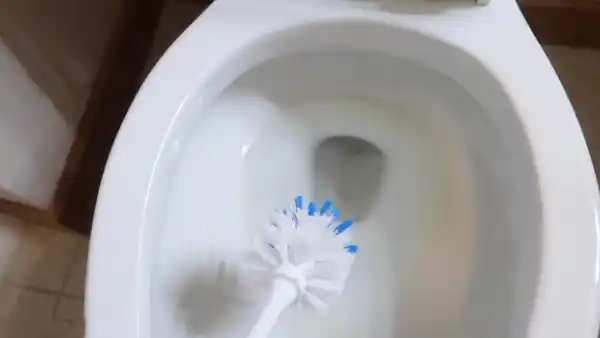
It’s no surprise that leaving your toilet bowl uncleaned for a long time can lead to a build-up of various stains and discoloration. While it’s important to ensure that you clean your toilet bowl regularly, the effects of leaving it unchecked while on vacation can be extreme.
1. Mineral Stains:
Mineral deposits are one of the most common effects of leaving a toilet bowl without proper care for an extended period of time. These toilet bowl stains usually form in areas consistently exposed to moisture, such as around the water line or at the bottom of the bowl.
These deposits form when hard water evaporates, leaving behind minerals such as calcium, magnesium, and iron. Over time, these minerals accumulate in layers and cause both yellow and brown stains on porcelain surfaces.
In some cases, these mineral deposits can be tough to remove with traditional cleaning methods, but there are ways to get rid of them. Using a mixture of vinegar and baking soda is often effective in removing stubborn mineral stains from porcelain surfaces.
2. Rust Stains:
Rust is another type of staining that occurs when a toilet bowl is not cleaned regularly while away on vacation. Iron is a common component found in tap water, which leads to rusting if left unchecked over time.
It tends to form in areas with consistently high humidity or moisture exposure near the handle or where drains enter the toilet bowl. The best way to remove rust from a porcelain surface is by scrubbing it with steel wool or using an acid-based cleanser specifically formulated for stain removal.
3. Copper Stains:
Copper staining is caused by high levels of copper present in tap water instead of iron, which creates blue-green stains at the bottom or sides of toilet bowls when left unchecked over time.
To remove copper stains from porcelain surfaces, use white vinegar mixed with water and scrub until all traces are gone. You should be able to remove most minor copper stains with this method.
4. Mold Stains:
Mold staining occurs when bathrooms stay damp over long periods without being properly ventilated or dried off after every use. This can cause dark brown patches along with discoloration around sinks, bathtubs, and toilets due to mold spores growing on wet surfaces over time.
To effectively remove or prevent mold staining from porcelain surfaces, use chlorine bleach diluted with lukewarm water and scrub until marks have been removed. This should take care of most minor mold staining and mildew issues.
5. Virus and Bacteria:
Bacteria and viruses love moist environments such as those found inside toilets where there’s plenty of moisture for them to thrive on. These microbes need some kind of food source such as bodily fluids like sweat or blood in order for them to multiply rapidly before becoming noticeable.
Without proper cleaning and disinfecting, vacationers risk returning home to an unhealthy environment caused by bacteria and viruses that have had plenty of time to accumulate.
To prevent any unpleasant surprises upon re-entry, make sure you use toilet cleaner containing hygiene-boosting agents like bleach before taking off on your journey.
Should I Cover My Toilet with Saran Wrap?
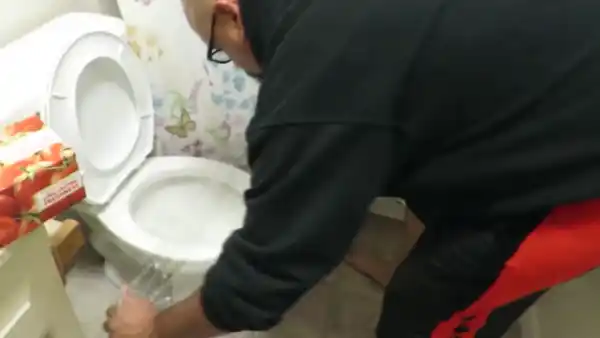
Covering your toilet with saran wrap when going on vacation helps maintain proper hygiene while you’re away as it prevents evaporation of water from inside your bowl which can cause bacteria growth over time.
Furthermore, covering it with plastic also keeps insects out since they cannot penetrate through it easily due to its tight seal against both surfaces.
Since saran wrap is transparent, any potential issues inside your bowl can be seen without opening up its lid. This allows for quick troubleshooting in case something goes wrong before you come back from vacation.
How Long Can You Leave Vinegar in The Toilet?
Most people recommend leaving a mixture of vinegar and water in the toilet for no longer than 30 minutes. This distilled vinegar should be enough time to loosen any buildup and get rid of unpleasant odors, but you should not leave it any longer as doing so could lead to damage to the toilet.
Should You Leave the Toilet Lid Up or Down When You Go On Vacation?
When going on vacation, it is recommended that you keep the lid of your toilet closed at all times. This is because if it’s left open, dust and other particles can settle inside, causing bacteria buildup which can lead to health problems for anyone using that bathroom when you return home.

Why Should Guys Put the Toilet Seat Down?
Putting down the toilet seat after use is considered good etiquette by many people since it will leave your toilet smelling fresh and free from any buildup. Having a closed lid reduces splashing, which could lead to spills and messes on the floor or walls outside of the bathroom.
It also helps by keeping germs contained within the bowl which would otherwise escape if left up and become airborne around your house or apartment.
Keep Your Toilet Spotless All Vacation Long
Keeping the toilet bowl clean on vacation is possible with the right strategy and effort. Whether using an acidic cleaner or hydrogen peroxide or putting marine antifreeze in the bowl before leaving for holiday breaks, these tips can help prevent build-up in the toilet bowl during long absences from home.
Additionally, practical strategies such as giving the toilet a deep cleaning prior to leaving for a vacation can also be beneficial. By following our tips and advice above, you should have no problem keeping your toilets spick-and-span while on your well-deserved break.

